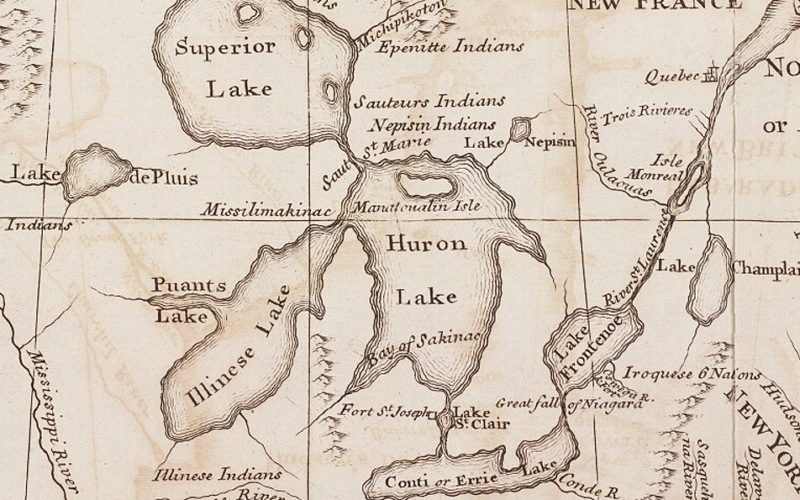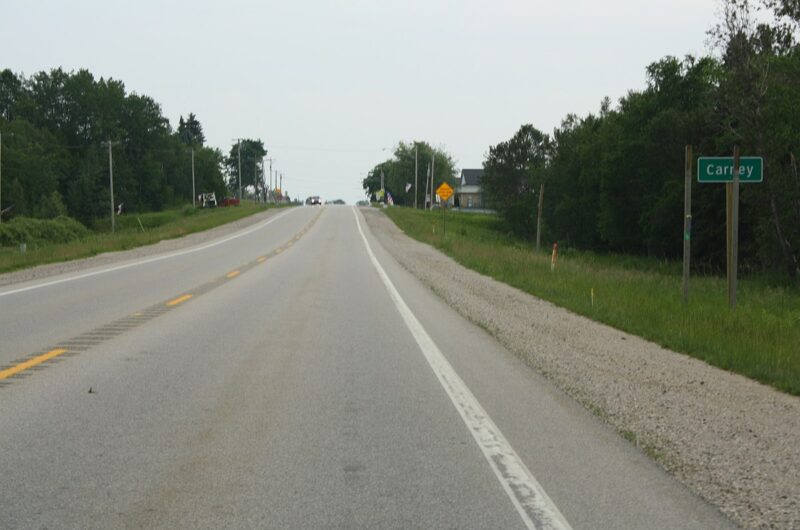The French Regime in the Upper Peninsula – Part One

“Rural Voices” shares cultural, educational, economic and artistic views of people who have lived and thrived in the Upper Peninsula. Each of our authors in Rural Voices may be living here in the U.P. or living someplace around the globe, but the U.P. is an important part of who they are and what their beliefs and values are today. Rural Voices wants to share the voices of our neighbors and friends about life and experiences in the UP.
PART 1
FRENCH REGIME IN THE UPPER PENINSULA
For 176 years, the Upper Peninsula was governed by France and England. These European powers came to the interior of North America seeking economic profit based on the fur trade and establishing posts at strategic locations, which became the first settlements. The Native Americans were their trading partners and were seen as souls to be saved by the Jesuit (Society of Jesus) missionaries.
French Origins of the Fur Trade
In order to best understand the French experience in the Upper Peninsula we must go back to France. As a major European nation, France was concerned with internal political development and European affairs. Furthermore, France was a prosperous nation with a generally homogenous population and few Frenchmen saw the need to leave their homeland, unlike the seafaring and colonizing Portuguese, Spanish and English.
The first Frenchmen to approach North America on a regular basis were commercial fishermen out of the Channel ports. These adventuresome fishermen sailed to the Grand Banks of Newfoundland seeking cod fish, which given Catholic dietary practice – fish had to be consumed during half of the year –was in great demand.
However fishing was a dangerous and unpredictable proposition. As the Frenchmen landed on the coast processing their catch they encountered local Indians who had furs, which would be in great demand in the Old Country. These fishermen soon found that these valuable furs could be traded for such common and inexpensive items as pots and pans, mirrors, knives, textiles and beads. Trade was safer and the outcome could be readily anticipated and so the fur trade entered North America.
Then in 1634, a new phase in the French story unfolded. Jacques Cartier sailed to Canada and initially explored the Gulf of the St. Lawrence. The following year he sailed up the St. Lawrence River seeking the Strait of Anian, a mythical passage to China. He visited the future sites of Québec City and Montréal where the Indians gave him “red metal” or copper and told him of the Sweet Water Sea or the Great Lakes to the west.
After spending an extremely difficult winter braving Canada’s frigid continental climate, he sailed home with the idea that this “ice box” had little to offer. Despite the harsh winters, the French continued to seek gold and the elusive Strait of Anian.
Samuel Champlain and New France
Through the sixteenth and into the seventeenth century, the French continued to hope to settle Maritime Atlantic Canada. They turned their attention to the area of the Bay of Fundy in the area of modern New Brunswick and Nova Scotia, and called the area Acadia. Probably the most important development was the arrival of explorer, geographer, and the father of New France, Samuel de Champlain. He visited many areas of the Canadian coast and saw that that development would have potential value. However settlement in this exposed area on the coast was precarious because of English raids from the south. A French foothold in Canada would have to take place in the interior.
On July 3, 1608 Samuel de Champlain, established a permanent settlement at Québec City. The settlement developed slowly, but Champlain was a strong leader who promoted the new colony. It became obvious that its economy had to rely on the familiar fur trade. The fur trade readily fit into French colonial plans for the sparse settlement was most suited to fur-bearing animals’ habitat, and to the Natives who trapped them.
In order to understand and appreciate the supply side of the fur trade it is critical to realize the European demand for furs. Naturally the highest quality furs came from regions with the most severe winters, and here the Upper Peninsula was an ideal location. Furs were destined for luxury clothing and for the felting industry which produced hats. Beginning in the late seventeenth century under the direction of Louis XIV, Paris developed as the fashion capital of Europe and determined fashions.
In Europe fur was in demand for decorative material and a new material to use for coats, cloaks and associated dress. Hats were a mandatory part of everyday dress for men and women. Beaver pelts which were processed into hats felt were in demand because they were water resistant, held their shape when wet, and remained in demand until the nineteenth century when silk hats became the fashion.
Champlain had many creative ideas for the development of the colony. To unite the French and the Native Americans, he envisioned a kingdom composed of métis or mixed-bloods of Native American and French origin. Then in 1612 he secured a trade alliance with the Huron Indians and in the process fought their bitter enemies the Iroquois of western New York. Although the early battles were French victories, Champlain and the French gained the enmity of the Iroquois and this would have a direct effect on the French entry and development of the Upper Peninsula.
Champlain, known for his curiosity and exploring ability, traveled northwest from Montréal up the Ottawa River and visited Georgian Bay and other parts of Lake Huron, giving the French an easy and natural route into the Great Lakes and the west. Champlain also introduced the idea of uniting the French and Native people through education. Teenagers from both communities would spend the winter in the others’ community. The Indian could assimilate French ways, while French youths would learn Native lore, geography, language, kinship relationships, commercial practices, and other valuable knowledge and expertise that would be invaluable to them as explorers and traders. This information greatly assisted the French fur trade as Champlain moved westward. Correspondingly, Native children were taken into French communities and taught the French way of life in the local schools.
French Explorers
Once the initial settlement was made, Champlain wanted to know about the interior of the country. Two of the earliest known explorers and coureurs-de-bois were Etienne Brulé and Jean Nicolet who had lived with the Indians and gained Native knowledge.
The first known explorer into the Lake Superior Basin was Etienne Brulé (c1592 – cJune 1633) who in the winter of 1610 lived with the Algonquins and impressed Champlain with the knowledge he gained. He and a companion Grenolle traveled into the Great Lakes country in 1621-1623. They were the first known Europeans to visit the rapids at Sault Ste. Marie, which they named Gaston Falls, and to enter the Lake Superior country. Since he did not leave a journal or correspondence, we have little accurate and detailed information about this early visit to the Upper Peninsula. It is reasonable to assume that these Frenchmen were exploring the territory with the idea of establishing trade with the Indians. Besides noting the fur trade, Brulé in 1621 possibly noted the copper deposits.
The friend of Champlain and Brulé was Jean Nicolet (c1598-1642) who lived with the Indians and was prepared to travel into the interior. In 1643 he was sent by Champlain to seek a route to Asia. After traveling through the Straits of Mackinac and coasting along the Lake Michigan shore of the Upper Peninsula he explored Green Bay and learned from the Ho-Chunk (formerly called Winnebago) that the French were not close to the South Sea or Pacific Ocean, his goal. He returned east with the disappointing information.
The next most important exploration and fur trading expedition into the Lake Superior country was that of Médard Chouart, Sieur des Grosseilliers (1618-1696) and his brother-in-law, Pierre-Esprit Radisson (1636-1710) who ventured into the Lake Superior Basin in 1659-1660.
They entered by way of Sault Ste. Marie, skirted the south shore of Lake Superior, portaged the Keweenaw Peninsula, and built a cabin on Chequamegon Bay. When they returned to Québec with cargoes of the finest furs, Governor Frontenac fined them several million dollars for traveling west without authorization. Angered by this treatment, they traveled to England, met with influential backers, and as a result the Hudson Bay Company was formed in 1670. This development was a blow to the French fur trade on Lake Superior because Indians could travel north and trade with the English. In southernmost James Bay several small trading posts were established, which, though remote, had the effect of attracting Native traders from Lake Superior. The English attracted Native Americans with cheaper goods and higher fur prices.
As a result of these exploratory ventures into the Great Lakes region and in particular the Upper Peninsula, the French realized the importance and potential of the fur trade. The upper Great Lakes with the Straits of Mackinac as its focal point would develop into the heartland of the fur world. The trade was in the hands of the voyageurs and the coureurs-de-bois (woodsmen, literally “runners of the woods”) both of whom were entrepreneurial workers. The difference between the two was especially evident after 1681, when the trade was limited in order to maintain profits and licenses or congés were issued. The voyageurs adhered to the capitalistic model and either got the permits or worked for legitimate merchants while the coureurs remained unregulated and at times were viewed as outlaws by officials. This trade which centered on the Upper Peninsula gained a global market and become the envy of the English and their Native allies who sought to capture and dominate this trade.
Huron and Odawa and the Western Missions
As part of his colonial project and as a Christian, Champlain wanted the Indians to be evangelized not only to assist their assimilation into French society but to save their souls. As a result, he brought a group of Recollects, a reform branch of the Franciscans with him to New France. Early they realized that their finances and numbers were limited and they turned the missionary field over to the Jesuits. The Jesuits arrived in New France in 1625, and a year later they were working among the Huron and other Indians in the St. Lawrence valley.
The Jesuit priests, who dominated the missionary field in New France, were founded by Ignatius of Loyola in 1539-1540 as a teaching order within the Catholic Church. However as the Americas were opened, these well-educated priests focused on evangelization. As part of their work they became fluent in the native languages, which they studied along with understanding the geography and environment they would encounter. Their reports, found in the Jesuits Relations and Allied Documents, provide scholars with a wealth of information about the Upper Peninsula in the seventeenth century.
At first the Jesuits ministered to the Huron Indians living in Huronia, the land between Lake Ontario and Georgian Bay. This work began in 1626 and continued for many years. In the midst of their endeavors, the Jesuits received an invitation from the Ojibwe at Sault Ste. Marie. In October 1641, Jesuits Isaac Jogues and Charles Raymbault traveled west and visited these Indians. They said Mass in the U.P. for the first time and met with tribal leaders. However they had to delay returning to the U.P. because of their work in Huronia.
About this time the Iroquois Confederacy united for an ongoing series of attacks and raids against the Hurons and the Jesuit missionaries. The Huron were killed or seized as captives, and life was dislocated.
The surviving Huron, Odawa and even some Nipigon fled westward through the Straits of Mackinac and temporarily settled along the shores of Green Bay. The Nipigon fled to the lake named after them in the northwest corner of Lake Superior. Pursued by the Iroquois, the Huron and Odawa pushed westward across Wisconsin into Minnesota where they were rebuffed by the Dakota, who forced them back into northern Wisconsin. The two tribes finally settled in Chequamegon Bay (modern Ashland, Wisconsin), where they developed villages, lived off the land and farmed. They were soon joined by French voyageurs and couriers-de-bois and the fur trade began in earnest. Tribes from Illinois, far to the south, traveled north to trade at this important center. Unfortunately, the French traders were not literate men and did not leave a record of their voyages.
Naturally, news of these developments spread eastward and the Jesuits who had so successfully evangelized the Huron decided to continue their work in the Lake Superior country. In 1660, René Menard, S.J. (1605-1661) was assigned by his superiors to establish a mission among the Huron in Wisconsin. This was the first time that the missionaries devised plans to establish a mission in the Lake Superior country. Menard accompanied a group of Odawa returning to Chequamegon Bay.
The trip was difficult for the aged Menard, and he wintered part-way at Keweenaw Bay where he established the mission of St. Therese. He was unsuccessful in this evangelization and in the spring of 1661 headed west for the Huron-Odawa villages on Chequamegon Bay. He died in northern Wisconsin–possibly killed by Dakota warriors–thus ending the first missionary attempt at establishing contact with the Huron.
Despite this setback, the Jesuits did not forget the Huron. In 1665 Claude Allouez, S.J. traveled westward and successful established the mission of La Pointe du Saint Esprit (“the Point of the Holy Spirit”) at Chequamegon. After their earlier disastrous results of congregating the Indians of Huronia, Allouez and the other Jesuits now established chapels and residences among the Indians in their villages, but the Odawas obstinately refused their teachings.
While in the Lake Superior country Allouez expanded the work of the Jesuits. He explored the land and waters of the region and sought out new Indian tribes to convert. He was probably one of a number of Jesuits who traveled the shores of Lake Superior and drew some working maps that would eventually form a surprisingly accurate map of the big lake. The local Native Americans showed him the copper deposits in the western Upper Peninsula. Allouez eventually returned to Québec with this wealth of information about Lake Superior and the northern shore of the Upper Peninsula.
The canoe voyage from Montréal to Chequamegon was long and the Jesuits sought a midway point where they could rest and recuperate enroute. One obvious location for a mission–because of the large number of Indians who lived there and visited the site to fish during the summer–was Sault Ste. Marie on the St. Mary’s River. In 1668, the Jesuit missionaries, Louis Nicolas and Jacques Marquette were sent to Sault Ste. Marie to establish the mission of St. Mary among the Ojibwe, the second mission in the Lake Superior country.
These French religious outposts, which consisted of a chapel and residence surrounded by a palisade, had to be self-sufficient in terms of food production. Furthermore, the fathers felt that agriculture would help assimilate the Ojibwe who were traditionally semi-nomadic fishers, hunters, and gatherers. The Jesuits planted wheat, peas, turnips, chives, garlic and possibly maize and soon some Indians followed their example, thus introducing farming to the Upper Peninsula over 300 years ago.
The situation at Chequamegon began to change as the Dakotas to the west in Minnesota developed hostile relations with the local Huron and Odawa. Furthermore, news had arrived that in 1662 an Iroquois war party had been defeated at Point Iroquois, west of Sault Ste. Marie by a combined force of Ojibwe, Odawa, Nipissing, and Amigone. As a result the Iroquois no longer posed a threat in the area of the Straits of Mackinac where abundant white fish provided sustenance. As a result the Huron and Odawa at Chequamegon soon decided to return to the Straits.
Hearing that the Huron and Odawa intended to move to Mackinac Island, Father Claude Dablon, S.J. spent several months in the Straits area seeking the best site for a new mission. The Indians had made their decision to move, and the missionaries packed their belongings and joined the migration in 1671.
Part 2 of our three-part series will be published here on Friday, March 5th.






good stuff. I was born and raised in Ironwood, went to MTU, and have lived in WI for over 40 years.
Great summary. The Iroquois sure were a tough bunch. If not for them, the southern great lakes would have been settled first.
My Great Grand parents on my mother’s side immigrated from Belgium in 1900 where my Great Grandfather found work in the mines around Norway Michigan, where my Grandfather was born in 1907, ( oddly enough he would attend school with a teacher who would become my wife’s great grandfather) following My Great grandfather’s death in a mine collapse during the first world war, my Great grand mother moved the family to different locations where the boys could find work, and the Belgian language was spoken, ( first to Superior Wisconsin, where my Grandfathers second older brother and he found work on the ore docks, ( the oldest boy was at the time in the army) then to Kimberly Wisconsin, where they worked in the paper mills, not liking the climate in Kimberly and with the threat of labor violence in the air Great Grandmother moved the family again, minus my Grandfathers eldest sister who married and settled there, to Mishawaka Indiana where the boys worked at Studebaker, and Ball Band, while my Grandfathers younger sister worked as a domestic and the two younger boys were still in school my Grandfathers two older brothers moved to Chicago where the eldest worked as a janitor, ( he could no longer do heavy work due to being gassed in France the effects of which killed him in 1960) and the second eldest served as an Evanston Police Officer, shortly after my Grandfather married my grandmother they too moved to Chicago settling in Evanston where they resided for the rest of their lives, and where my mother was born.
Besides appreciating the natural beauty, especially the lakes, residents and visitors cannot appreciate (and understand) the Upper Peninsula if they don’t appreciate the history. Many have no idea of the close connections to the 10,000 year history of tribal peoples and the 400 year history of European settlers and exploiters. The problems of the Upper Peninsula today can be traced to the UP’s history.
Thanks for this series.
Great article, thank you! It would be very interesting to know if DNA testing has been done on any of the Indian tribes in the upper Midwest. Dr. Spencer Wells with the National Geographic Genographic Project might be interested in pursuing that as an excellent tool for discovering the history of the tribes.
Jacques Cartier came to the St Lawrence in 1534. There was a typo in the beginning of this excellent article.
Agreed about the typo.